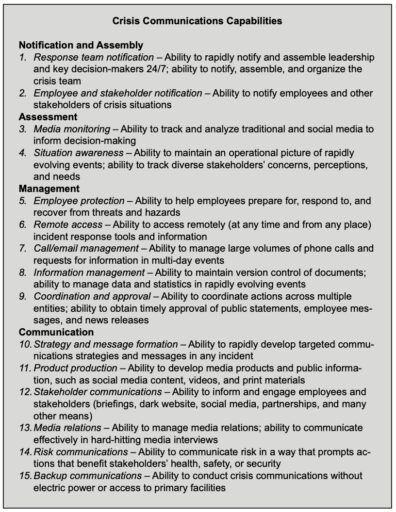Crisis communications planning is key to any emergency preparedness effort. One reason that so many organizations struggle with communications when crises strike may be that they focused their planning efforts on the crisis plan document without creating a shared vision of desired outcomes. They failed to define what they actually needed to do to communicate.
Surely, the plan is essential to communications. But plan execution requires strong leadership, trained personnel, well-established relationships, accessible technology, and resources. What is needed is a shared understanding of desired outcomes and the ability to perform a series of well-defined functions (capabilities) to achieve those outcomes. Capabilities define what you need to be able to do to overcome barriers to communications, such as inoperability and lack of situational awareness.
Crisis Communications Capabilities
Those familiar with the National Preparedness Goal (Federal Emergency Management Agency) and Public Health Preparedness Capabilities: National Standards for State and Local Planning (Centers for Disease Control and Prevention [CDC]) will recognize the capabilities approach. The principle should apply to crisis communications as well.
Well-defined capabilities – anchored in a clear vision of the end-state – provide a basis for not only crisis plan development, but also leadership coaching, employee outreach, exercise design, and partnership development. Capabilities enable leaders to see the crisis challenge in all its dimensions and resist the tendency to prematurely commit to a given script or technology.
The CDC lists 15 crisis communications capabilities that can be used to drive a planning approach. The capabilities apply to all types of scenarios. For example, the ability to rapidly notify and assemble leadership could be needed following a cyberattack, a natural disaster, a major fire, a reputational threat, or any situation requiring a rapid response.

Crisis Planning Questions
The following questions should be asked when incorporating these capabilities into the planning process:
Based on personal and organizational experience responding to crises, which capabilities require immediate attention? Where are the gaps?
What priorities come to mind in light of the organization’s primary threats and hazards?
How do staff assignments and the organization of the team align to the capabilities? What additional roles and responsibilities come to mind?
Which capabilities require subject matter expertise beyond the planning team? What types of partnerships are needed?
Which capabilities require relationships with legal counsel, security, mission assurance, information technology, human resources, or operations?
What training and exercise objectives come to mind in light of these capabilities?
With a holistic view of the end state, emergency planners and leaders can more effectively assess all aspects of their crisis programs. Although pre-approved communications policies, procedures, and messages may, in fact, be in fairly good shape, it may be necessary to rethink the capabilities to ensure that the organization is actually capable of communicating when crisis strikes.

Thomas Wahle
Thomas Wahle specializes in crisis communications and disaster preparedness for Booz Allen Hamilton. He has 28 years of experience supporting government agencies and private sector organizations in homeland security, transportation, energy, intelligence, and defense markets. Previously, he was a radio news reporter and anchor.
- This author does not have any more posts.






